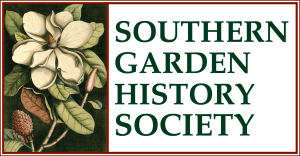
Credit: Marion Brenner, courtesy of the Garden Conservancy
Society members walked about what was then known as Peckerwood Garden during the Sunday tour of the March 1999 Houston annual meeting. What they encountered was a garden which at the time was less than thirty-years old. They also found one rooted in the ingenuity and drive of John Gaston Fairey, a native of South Carolina who moved to Texas after receiving fine arts degrees in the East. Once there, he began teaching design at the Texas A&M school of architecture, while also bringing a love of gardening to the Lone Star State. It was this combination of talents and inclinations that led him in 1971 to purchase the first seven acres of what he would name Peckerwood Gardens, making fun of himself and his southern origins in the process.*
Several sources note that after a careful study of the site, uniquely set where several climate zones meet, Fairey partnered with George Clary at nearby Waller Nursery to begin installing the basic vegetation needed to populate his garden. The coming two decades were marked by expanding acreage, repairing major storm damage (an oft-told story of southern gardens), and partnering with two highly-regarded Texas plant authorities, Carl Schoenfeld and Lynn Lowrey. The former, a widely recognized plant explorer, partnered with Fairey and Peckerwood Gardens to open Hempstead’s Yucca Do Nursery. Also famed for his plant explorations and nursery operations, Lynn Lowrey was brought into focus for Society members by a Summer 1999 Magnolia lead article by past president and honorary board member, Mary Anne Pickens.**
Individually or together, they engaged in numerous plant-hunting expeditions to Mexico, Fairey himself being credited with ninety-plus such trips coordinated by Lowrey and the University at Nuevo Leon. Returning with materials from a wide variety of often-endangered species, the result combined with flora from other regions adds up to an “estimated 3,000 species of rare plants and cultivars” at the Fairey Garden.*** This author recalls noting in 1999 the interweaving of skillful design with the materials growing therein and being struck by just how very different this was from the Country Place experience we had just had at Bayou Bend. (See Bayou Bend post, January 17, 2025.)
Shortly before our Houston meeting, Peckerwood Garden had entered a new phase of its development through partnering as a “preservation garden” with the New York-based Garden Conservancy, that organization itself being less than a decade old at the time. As of today, the Fairey Garden stands alone in Texas enjoying such a relationship. Though still outweighed by sites found in regions outside of the South, the list includes other properties known to SGHS members and/or visitors to this page.****
Space limitations mean that a discussion of things grown and tended here must be cursory. Fortunately, the John Fairey Garden website cited below offers an excellent overview of both the rationale for the garden’s mission and its operations, along with the range and focus of the plants grouped there. Reflecting back to Fairey’s numerous Mexico expeditions, it notes that the pseudonymous assemblage is one the “defining collections of the garden.” The Mexico material, moreover, is of especial interest to Texans given the environmental resemblances between regions of the Lone Star State and its neighbor to the south. Visitors from other areas of the nation or abroad may also find the Oak Collection of special interest given the widespread ecological importance of the Quercus genus.
As the Fairey Garden website demonstrates, however, there is more to experience here than a grand array of Mexican plants and oaks, including a renowned Mexican folk-art grouping. Readers who wish to visit the Fairey Garden, however, should note that open hours are limited since this is primarily a research and preservation garden. Thus, to avoid disappointment it is wise to consult the visitation policy and the garden’s calendar, and plan your travel accordingly.
****************************************************************
*Readers might know that “peckerwood” is a derogatory term for rural white southerners.
**https://southerngardenhistory.org/wp-content/uploads/1999-Summer-Vol.-XV-No.-1.pdf#page=1
***https://jfgarden.org/collections/
****https://www.gardenconservancy.org/preservation/partners/john-fairey-garden

Leave a Reply